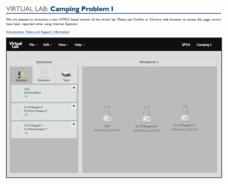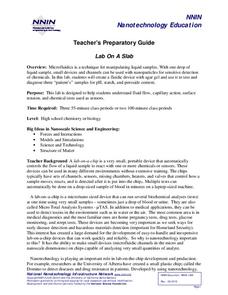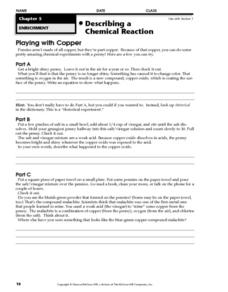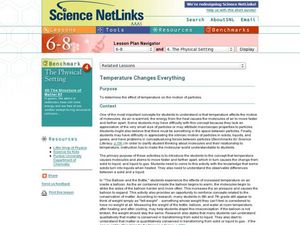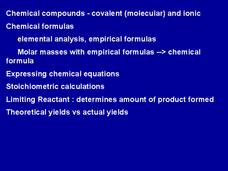Chemistry Collective
Virtual Lab: Glucose Dilution Problem
There's no diluted learning here! Young chemists conduct a virtual lab exploration to practice their stoichiometry skills. By manipulating simulated solutions, they create a solution of a specific glucose molarity.
Chemistry Collective
Virtual Lab: Acid Dilution Problem
There's no risk of injury when working with virtual HCl! Challenge your young chemists with making calculations to create a 3M solution of HCl from the concentrated acid. They first calculate the correct ratios of HCl and water and then...
Chemistry Collective
Virtual Lab: Identifying an Unknown Liquid from its Density
Mislabeled bottles can cause a dangerous situation! Young chemists design a method for determining the true contents of a solution in a virtual lab activity. Their study of density helps them identify the makeup of the solution.
Chemistry Collective
Virtual Lab: Gravimetric Determination of Arsenic
Arsenic in drinking water is a common problem in third world countries. Young chemists create a procedure to calculate the mass percent of arsenic in the soil. The virtual lab allows individuals to experiment with different methods.
Chemistry Collective
Virtual Lab: Determining Stoichiometric Coefficients
Investigate the reaction between four unknown substances using a virtual activity. Eager chemists examine the reaction between the four solutions to build a stoichiometric equation. The virtual workbench provides the tools necessary to...
Chemistry Collective
Virtual Lab: Stoichiometry and Solution Preparation Problem
Wow your classes with lesson that has a little of this and a little of that! Young chemists test their stoichiometry skills using a virtual laboratory setup. Using reaction information, they work to create a chemical reaction in which...
Chemistry Collective
Virtual Lab: Textbook Style Limiting Reagents Problem II
Textbook problems with a twist! Young chemists analyze an ionic reaction to identify the limiting reagent. They then make calculations to determine the concentration of unknown solutions. Finally, they put their work to the test and...
Chemistry Collective
Virtual Lab: Camping Problem I
Hiking chemists have an advantage! Young scholars use a virtual lab to conduct an experiment to create an exothermic reaction. The goal is to create enough heat to warm a meal during a hike in the rain.
National Nanotechnology Infrastructure Network
Lab On A Slab
Capillary action is the frugal chemist's dream ... the less liquid used, the more tests they can run! Learners experiment with the best design to maximize the benefits of capillary action. Using a liquid sample, they design a capillary...
American Chemical Society
Atoms Can Be Rearranged to Make Different Molecules
Uncover the building blocks of the universe as budding chemists explore atoms and molecules in an exciting inquiry-based activity. Investigators view an interactive video describing the chemical structure of six molecules. Using...
Curated OER
Models of Chemical Families
A simple activity for introductory chemistry classes is thoroughly explained in this lesson plan. Each individual receives a sealed box containing an unknown object. Inquisitors use indirect evidence to draw conclusions. This activity is...
Curated OER
Patterns in Electron Configuration
A periodic table of elements and ten accompanying questions comprise this chemistry handout. Learners survey the table to discover the relationship between group columns and valence electrons. They also associate energy levels to the...
Curated OER
Describing a Chemical Reaction: Playing with Copper
Three experiments involving pennies help young chemists see the chemical reactions between copper and other elements. The first experiment is rhetorical (it prompts students to leave a bright penny out for a year) but the second two...
Curated OER
Periodic Trends
Chemists compare the electronegativity, ionization energy, electron affinity, and ionic radius of different elements. This worksheet is composed of 11 multiple choice questions, and 8 written explanations. Critical thinking skills are...
Curated OER
Distinguishing Between Atoms
Every type of question is used to query young chemists about atomic structure. A vocabulary list tops the page before fill in the blanks, true/false, and matching questions are listed. This is a neatly formatted and pertinent...
Curated OER
Protons, Neutrons, and Electrons
Using the periodic table of elements, young chemists fill in a chart of isotopes to show the atomic number, mass, charge, number of protons, number of neutrons, and number of electrons. The chart is followed by 11 questions that...
Curated OER
Grade Improvement Options for Organic Chemistry - MCAT Exam Questions
The first two pages of this resource may not be useful as they contain a narrative as to how someone can improve their grade on an organic chemistry exam. The final page, however, contains four sample MCAT exam questions. You could use...
Curated OER
Temperature Changes Everything
Middle school chemists visit interactive websites in order to discover what happens to molecular motion when heat is added to matter. They conduct an experiment that demonstrates the expansion of matter with the addition of heat. A lab...
Curated OER
Formulas
There are two sheets here, with 100 problems total. The first half is a list of compounds, and your young chemists should write the chemical formula for each. The next fifty give the formula and the name is required. You could also use...
Curated OER
Algebraic Solving Method for Balancing Chemical Equations
The process for balancing chemical equations is stepped through slide by slide in this presentation. For some strange reason, the subscripts for certain elements are not dropped down on the first slide only, so you may want to copy the...
Curated OER
Group 14, The Carbon Group
Six slides summarize the details about group 14 in the periodic table, otherwise known as the carbon group. Young chemists will see facts about carbon itself, and then some general uses of related metalloids. This is a short and basic...
Curated OER
The Groups and Electron Dot Diagrams
It's all in the family with this presentation! The halogen, alkali metal, and noble gas families are introduced to young chemists along with characteristic properties and colorful diagrams of electron shells. Viewers are then taught how...
Curated OER
Chemical Compounds
Your young chemists will find these slides very informative. Groups and periods of the periodic table are labeled and described according to the charge. Comprehensive explanations of physical and chemical properties and how they relate...
Curated OER
The Structure and Properties of Polymers
A fifteen-slide presentation helps you teach your young chemists about monomers and polymers. You will find many graphics, some of them colorful, and bullet-point style notes on each slide. Although the presentation is informative,...









